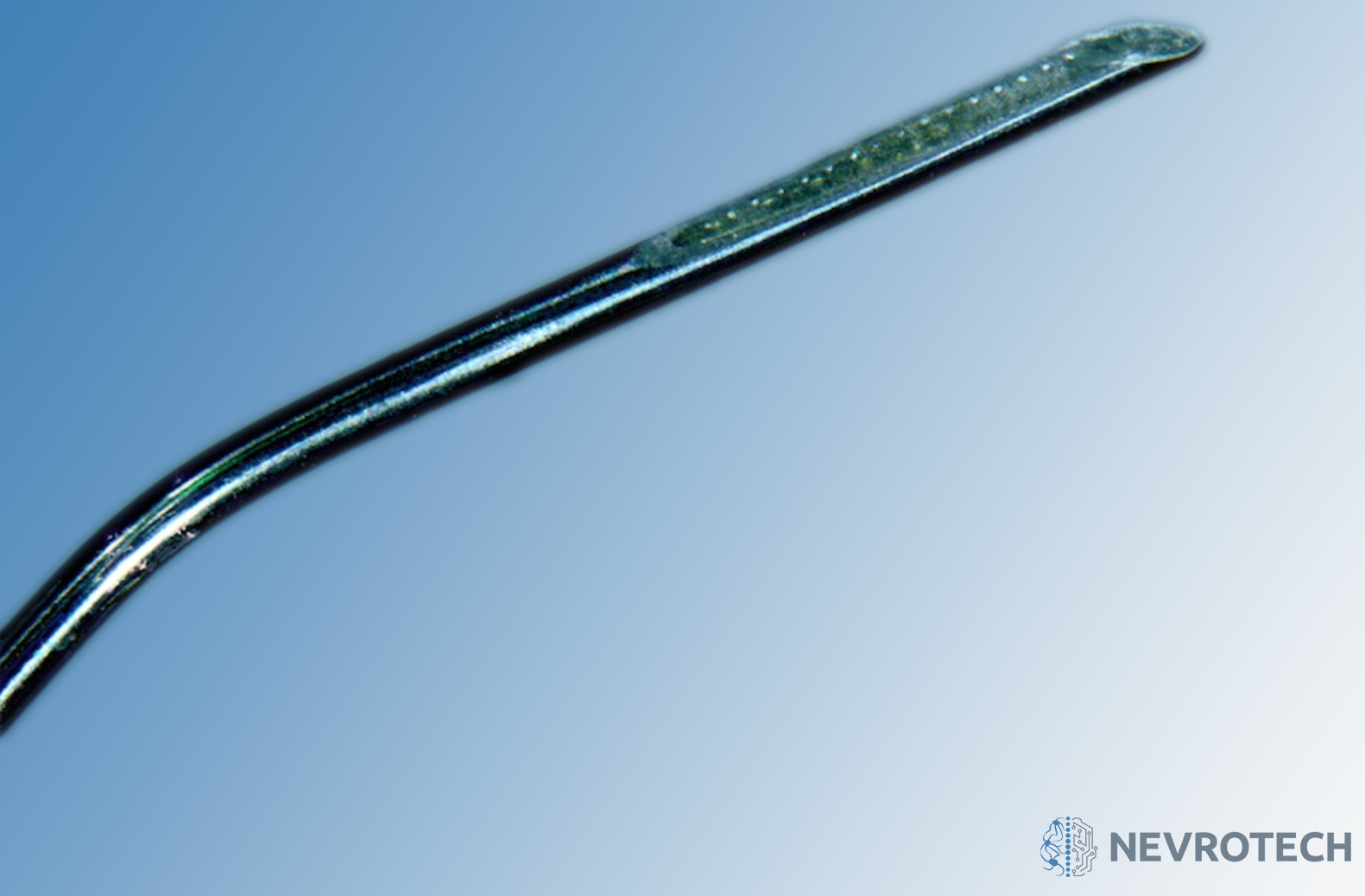Brain Slice Multielectrode Arrays have multiple recording sites in a configuration up to 32 electrode channels. These probes are bended at 45° to effectively record the neural activity from the surface of a brain slice.
Brain Slice Multielectrode Arrays - BMA
Such probes have an exceptionally durable structure that is also highly customizable. Brain Slice Multielectrode Arrays are available in linear, stereotrode or tetrode configurations and they are built into a stainless steel tube to provide support for accurate acute research.
The recording sites are placed on the bottom side of a Stainless Steel, “hockey stick” cone with a choice of 4, 8, 16, 24 or 32 electrode channels in a length up to 200mm. These Platinum/Iridium recording sites are available in 15, 20, 25 and 40μm diameter options. The smallest diameter of 15μm allows effective single-unit recording, and complemented with low impedance such probes have a better signal-to-noise ratio (SNR). Larger diameter probes are more suitable for field potential recordings.
Brain Slice Multielectrode Arrays have multiple recording sites in a configuration up to 32 electrode channels. These probes are bended at 45° to effectively record the neural activity from the surface of a brain slice.
Such probes have an exceptionally durable structure that is also highly customizable. Brain Slice Multielectrode Arrays are available in linear, stereotrode or tetrode configurations and they are built into a stainless steel tube to provide support for accurate acute research.
The recording sites are placed on the bottom side of a Stainless Steel, “hockey stick” cone with a choice of 4, 8, 16, 24 or 32 electrode channels in a length up to 200mm. These Platinum/Iridium recording sites are available in 15, 20, 25 and 40μm diameter options. The smallest diameter of 15μm allows effective single-unit recording, and complemented with low impedance such probes have a better signal-to-noise ratio (SNR). Larger diameter probes are more suitable for field potential recordings.
We can also build either capillaries or fibers into the Brain Slice Multielectrode Arrays for local drug delivery and optogenetical studies, respectively. The capillary fluid channel may need to be placed between the recording electrodes. Note that the minimum diameter of the probe may need to increase to accommodate these capabilities.
Multiple connector types are available for providing easy connection to your data acquisition system. It may also be possible to produce Brain Slice Multielectrode Arrays beyond the listed parameters to facilitate the most ideal setup for your research needs.
- Highly robust and reusable stainless steel construction
- Single, stereotrode or tetrode configurations available
- Acute recordings on brain slices
- Highly customizable design
- Platinum/Iridium sites (4-32 channels)
- Capillaries and fibers available
- Various connector types available
GENERAL
| Ideal method of use | Acute |
| Application method | In vitro |
| Research phase | Pre-clinical |
| Subject | Brain slices |
| Shape | Hockey Stick (electrodes are placed on the bottom side) |
| Linear | Y |
| Steretrode | Y |
| Tetrode | Y |
| Spacing if stereotrode or tetrode (µm) | Min. 50 |
TIP
| Angle (°) | 30, 60 |
| Material | Epoxy, Stainless Steel |
| Shape | Tapered (sharpened) |
SHAFT
| Material | Stainless Steel |
| Diameter (µm) | 185-360 (varies based on the number of electrodes and the use of capillaries and fibers) |
| Length (mm) | 10-200 (tip to the end of shaft) |
| Ferromagnetic | Y (non-MRI compatible) |
ELECTRODE SITES
| Material | Platinum/Iridium |
| Diameter (µm) | 15, 20, 25, 40 |
| Inter-electrode spacing (µm) | 50-500 (100 is typical) |
| Number of electrode channels | 4, 8, 16, 24, 32 |
| Tip to 1st site distance (µm) | Min. 200 |
CAPILLARY FLUID CHANNEL
| Applicable | Y |
| Material | Glass |
| Outer diameter (µm) | 75 |
| Inner diameter (µm) | 50 |
FIBRE OPTICS
| Applicable | Y |
| Diameter (µm) | 75, 125 |
REINFORCEMENT TUBE
| Applicable | N |
| Diameter (µm) | – |
| Length (mm) | – |
SILICONE DISK
| Silicone disk | N |
| Diameter (mm) | – |
| Thickness (mm) | – |
OTHER
| Connector types | Omnetics, Precidip (as per user’s request) |
| Lifespan | Reusable |
| Silicone cable between connector and probe (mm) | – |
| Special notes | It is important to test the capillary and/or the fiber optics before the first use. Cleaning is also recommended after each use. |
You may find downloadable content under Resources.
